Every trip leaves its mark on luggage. Maybe your suitcase looks fine from the outside, but sticky zippers or odd smells might tell a different story. If you have ever opened your bag and found crumbs, dirt, or mystery stains staring back at you, you are not alone.
Cleaning your suitcase after travel helps protect it and keeps germs away. Experts agree that proper care adds years to any bag’s life. This blog shares easy methods to clean your luggage inside and out using things most people already have at home.
Whether the case rolls on hard wheels or is covered in fabric, simple steps can make it look fresh again. No more worrying about stubborn grime or embarrassing odors before your next adventure.
Want a clean start every time? Read on for real tips anyone can use right now!
Key Takeaways
- Clean your suitcase inside and out after travel to remove germs, dirt, and odors. Use household items like soap, water, baking soda, and vinegar for effective cleaning.
- Regular cleaning prolongs the life of luggage by preventing mold growth and damage to zippers. Inspect for stains or odors often to tackle problems early.
- Avoid harsh chemicals when cleaning luggage to prevent damage. Natural solutions like vinegar can disinfect and deodorize without harming materials.
- Store luggage properly after cleaning in a cool, dry place with protective covers to prevent dust buildup and protect against scratches.
- Consider professional cleaning services for persistent stains or high-end bags still under warranty to ensure thorough care without voiding coverage.
Why Cleaning Your Luggage Is Important
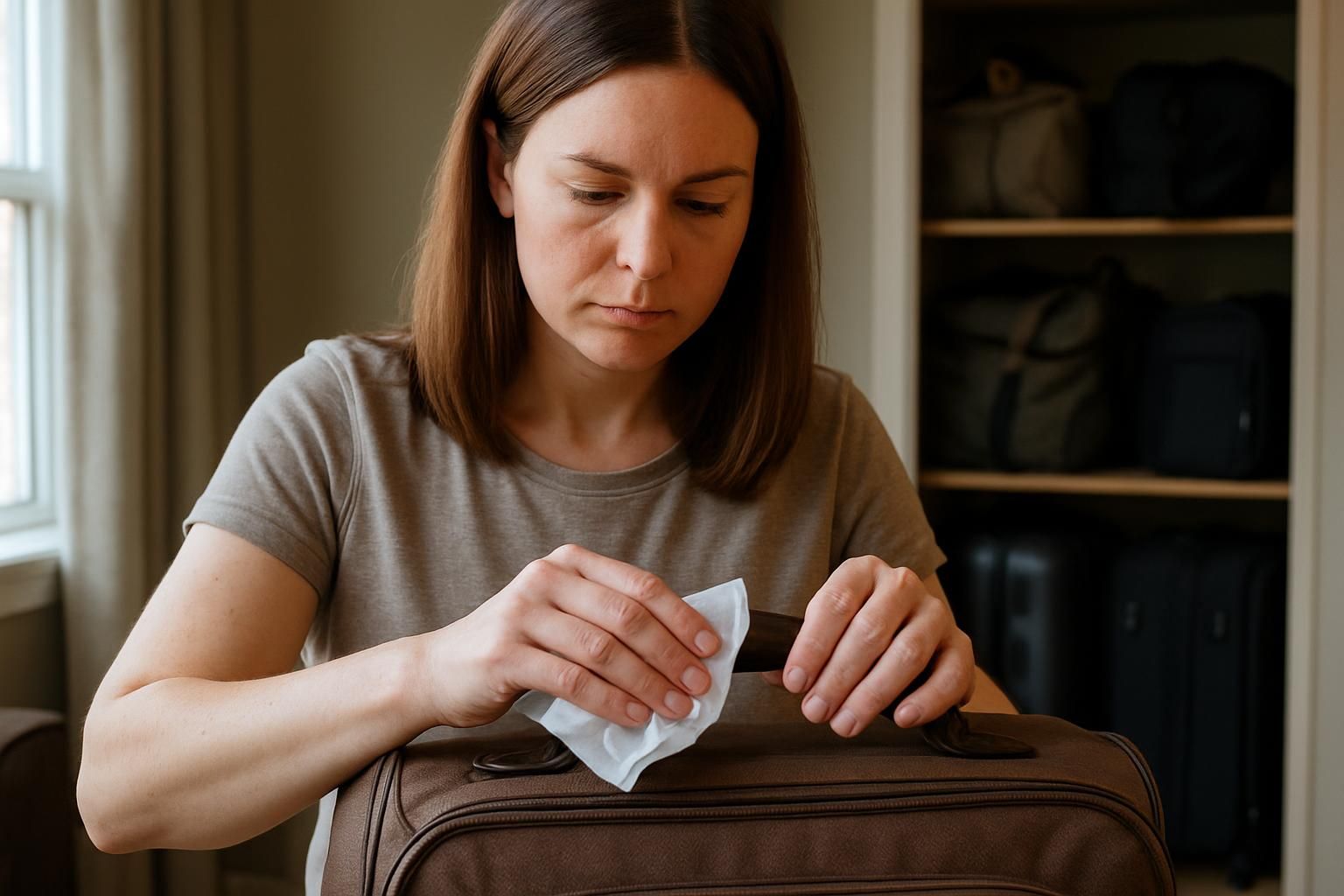
Moving on from the basics, parents and homeowners everywhere face strange stains clinging to suitcase corners after each vacation. Luggage rides along airport belts, through train stations, and inside taxi trunks collecting germs with every stop.
Cleaning your luggage keeps sanitation front and center; nobody wants hidden bugs or viruses tagging along into their living room. “A clean suitcase is a safe start for any journey.”.
Suitcases carry more than memories; they trap dirt, crumbs, sticky candy wrappers, and sometimes mystery odors. Travelers who skip cleaning risk mold attacks in storage closets or zippers that stick at the worst time possible.
Those who wipe down handles and sanitize surfaces help keep their family healthy while extending their bag’s durability for future adventures. Regular upkeep removes old debris so nothing unwanted comes home from that great trip away.
What You’ll Need to Clean Your Luggage
Gather a handful of basic supplies before rolling up your sleeves. A few extras can help tackle stubborn stains or ground-in dirt later on.
Basic cleaning supplies
Soap and water work wonders for routine luggage cleaning. Laundry detergent or dish soap tackles dirt on soft-sided suitcases. Use a microfiber cloth instead of paper towels; it’s washable and friendlier to the environment.
For stubborn stains, sprinkle baking soda onto the spot first, then scrub with a toothbrush or rag.
A all-purpose cleaner combines well with microfiber towels for hard-sided luggage care. Parents will appreciate disinfectant wipes containing at least 60% alcohol to handle germs after trips through airports or schools.
Keep vinegar handy for deodorizing musty interiors or erasing sticky marks from suitcase shells. Don’t skip a handheld vacuum or small broom; they banish crumbs stuck in corners and under linings faster than little fingers can find them again.
Next up are optional tools that take deeper cleaning up a notch.
Optional tools for deeper cleaning
After grabbing basic cleaning supplies, some suitcases call for extra muscle. Foaming fabric cleaner digs deep into stains on soft interiors. A small wet/dry vacuum sucks up big spills fast and helps with upholstery maintenance.
Magic erasers attack scuffs on hard-sided luggage with ease. Plastic-safe polish or wax-based furniture polish brings back lost shine to polycarbonate exteriors. One dad joked,.
Tiny scissors clip away frayed threads inside zippered pockets. To give wheels a real tune-up, use a screwdriver to remove them and clean out trapped dirt. These optional tools can bring surface restoration and stain removal up a notch, without breaking the bank or your back.
Preparing Your Luggage for Cleaning
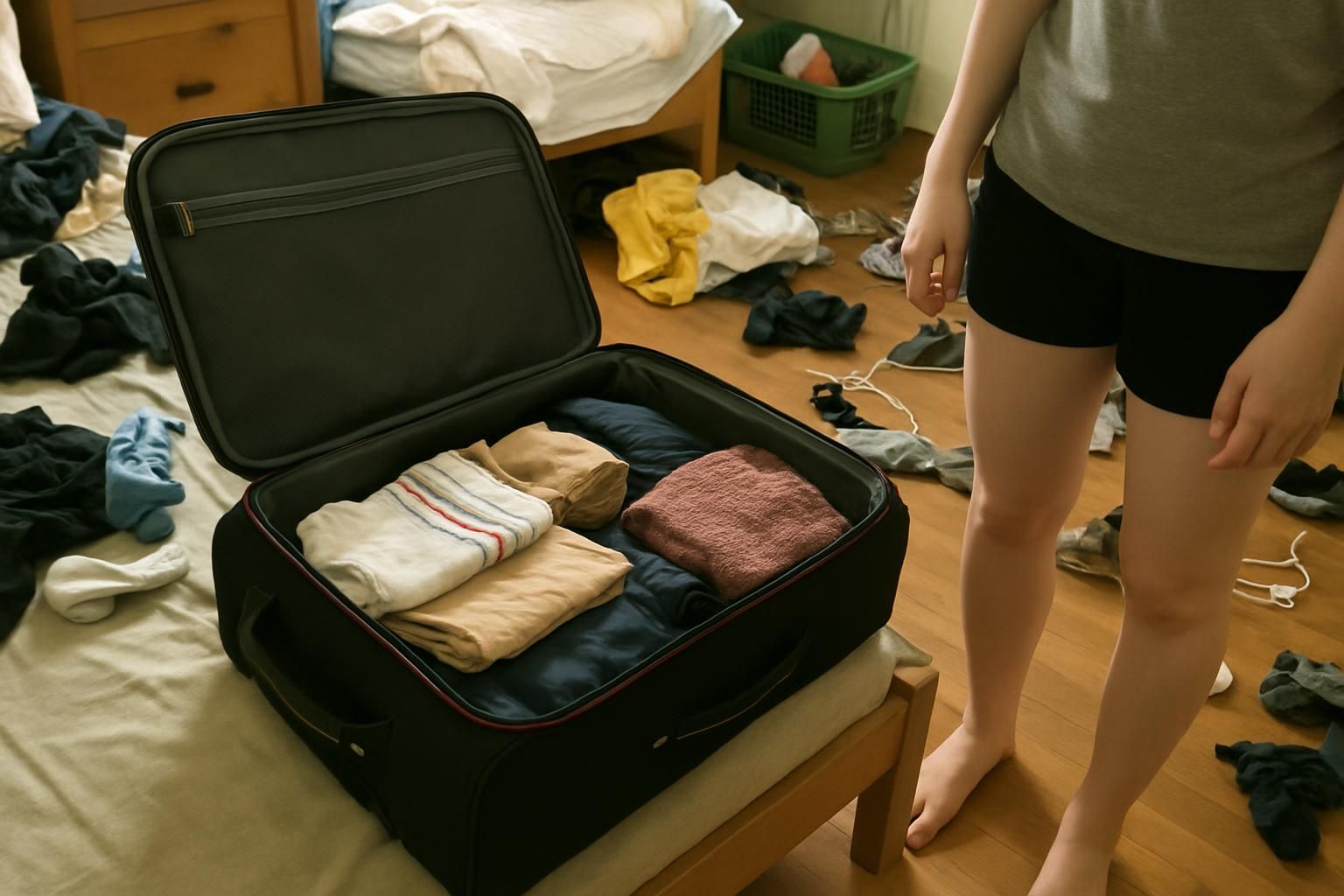
First, open every pocket and take everything out. Give your suitcase a quick check surprises like old snacks or sticky coins might hide where you least expect them!
Unpack and empty your suitcase
Unpack your suitcase in the garage to keep dirt and dust out of the house. Pull out everything. Clothes get tossed straight into the washing machine, no pit stops on beds or couches.
Use packing cubes if possible; they help keep clothes organized and make unpacking faster. Dirty cubes can take a trip through the wash too, while clean ones sit aside for 24 hours.
Dig deep for every last sock, shoe, or crumb hiding in pockets or corners. Shake debris loose over a trash bin before moving forward with cleaning. This small habit keeps travel grime from spreading through hallways or bedrooms at home.
Inspect for stains, damage, or odors
Scan your suitcase closely for stains and signs of damage. Spot muddy smudges, food spills, or oil marks on soft-sided luggage. These can cling to the fabric like stubborn relatives at Thanksgiving dinner.
Check seams and corners; bed bugs and debris love hiding there. Use a vacuum with an edge nozzle to root out these tiny squatters.
Strong odors may point to forgotten socks or spilled liquids from your last trip. Baking soda works well to tackle musty smells that linger in closed bags. Handles and wheels often wear layers of grime after rolling through airports and sidewalks give those areas extra attention during inspection.
Catching stains early helps prevent them from becoming a full-blown science experiment next time you open the suitcase.
Cleaning the Exterior of Your Luggage

Start with a soft brush or cloth and gently wipe away surface dirt. Stubborn spots might need a little extra scrubâjust don’t go overboard and turn your suitcase into modern art.
Hard-sided luggage
A damp microfiber cloth and a mixture of mild soap with water work best on hard-sided luggage, especially those made from polycarbonate or metal. Scrubbing with bleach, harsh chemicals, or abrasives can scratch up the surface faster than you can say âvacation.â For stubborn scuffs on travel gear, try a tiny dab of baking soda paste or give a magic eraser a quick pass.
Wipe handles and other high-touch spots using an alcohol-based cleaner for solid disinfection. Wax-based furniture polish brings back shine to polycarbonate shells while giving them extra protection.
Bleach belongs nowhere near your favorite travel accessoriesâstick to pH-balanced cleaning solutions instead. After those exterior cleaning steps, it is time to peek inside and tackle what’s lurking within the suitcase itself.
Soft-sided luggage
Soft-sided luggage made from nylon, canvas, or polyester needs gentle care. Wipe down the fabric using a microfiber towel soaked in soapy water for routine cleaning. For oil stains on the exterior, sprinkle baking soda over the area and wait about 15 minutes before vacuuming it up.
Dilute 1 tablespoon of laundry detergent in 8 ounces of warm water to blot away regular stains on soft-sided bags.
Tough spots can call for a small amount of non-toxic upholstery cleaner or a foaming fabric cleaner; use these sparingly. Bleach and abrasive scrubbers damage fabrics, so keep them far away from your suitcase.
A quick swipe with an alcohol wipe helps when there is no time for more detailed work. Spot clean stubborn marks by making a paste with baking soda; let it rest on the stain before wiping it off gently with a clean cloth.
Cleaning the Interior of Your Luggage
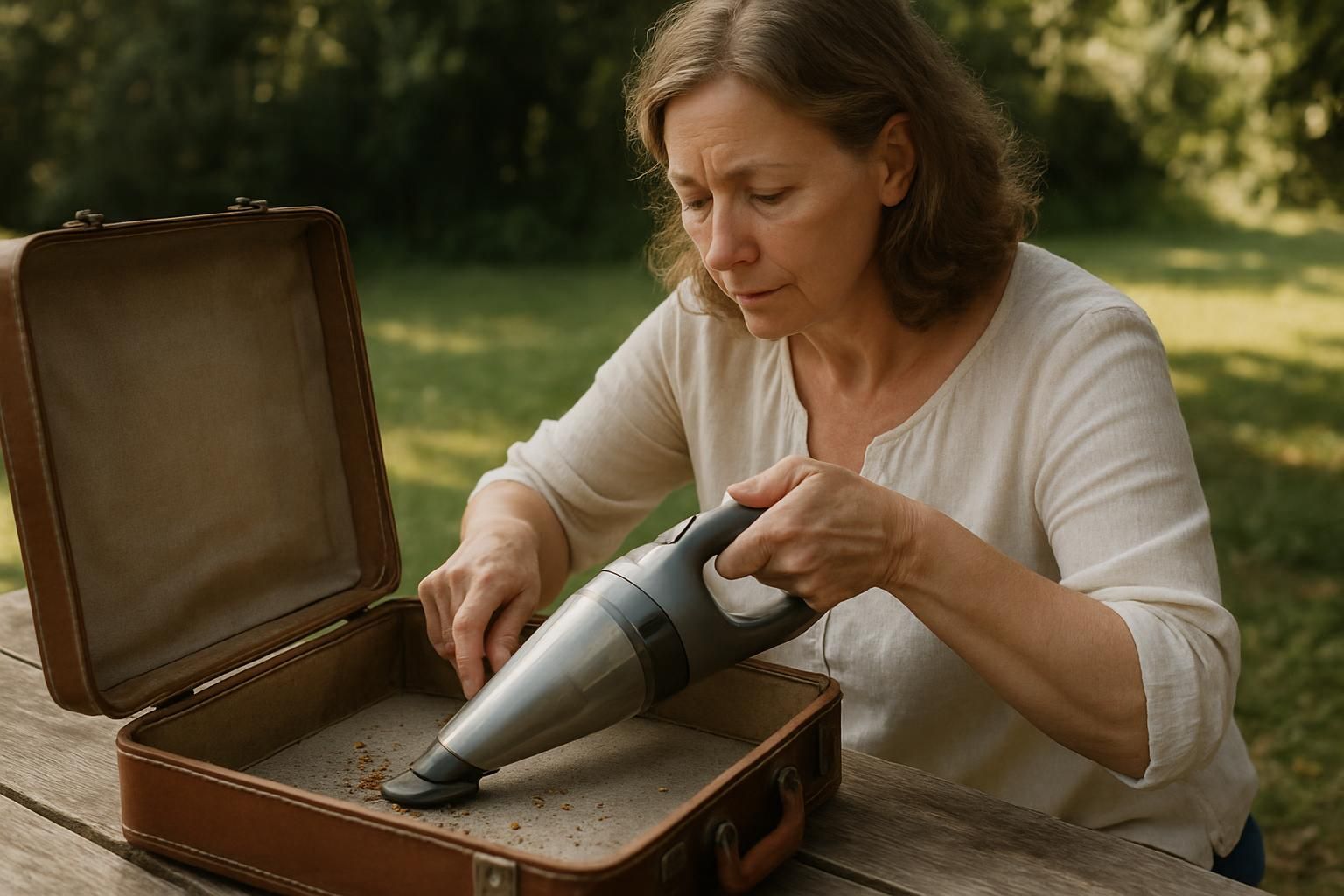
Dig deep into your suitcase’s insides and you might find old crumbs or a lone sock waving hello. A few simple moves can turn that stuffy space fresh and ready for your next adventure.
Removing debris and vacuuming
Shake out the lining outside to loosen dust and crumbs before getting started. Grab a handheld vacuum or small broom, then attack every corner and seam inside the luggage. Pay extra attention to pockets and zippered spots where debris likes to hide, especially old snack bits from family trips.
Vacuum out all those forgotten cookie crumbs lurking along seams. Parents often find tiny toy parts in the bottom; scoop them up before they get sucked away.
Kids sometimes spill drinks or snacks inside suitcases, so use a wet/dry vacuum for sticky messes or big spills. Always check interior seams and corners for signs of bed bugs while cleaning nobody wants hitchhikers on their next trip! Wash removable liners if possible, letting them air dry completely before putting things back together.
Take the vacuum bag or dust bin outside after each clean-up run to keep bugs and dirt from marching through your home.
Spot cleaning stains
Once crumbs and dust are gone, stains often stand out like a sore thumb. Stain removal on luggage lining works best with a mild detergent solution try one part high-efficiency (HE) detergent to five or even ten parts water.
Lightly scrub stained spots using a sponge or soft brush; never soak the fabric because too much moisture invites trouble.
Neutralizing odors
After tackling stains, odor elimination is next on the list for fresh luggage. Sprinkle baking soda inside the suitcase and let it sit overnight; this trick helps absorb even stubborn smells from last summer’s beach trip or that time someone forgot a banana in their carry-on.
Vacuum it all out the next day, making sure you remove both powder and trapped odors. Next, spray a light layer of fabric deodorizer to add freshness without overwhelming sensitive noses.
Never pack wet clothes straight into your suitcase; pop them in a waterproof bag to avoid musty surprises later on. Air dry the case fully after cleaning because moisture invites mold like ants at a picnic! For extra defense against future funk, some parents use Scotchgard but always test first.
Detailed Steps for Cleaning Fabric Luggage
- To effectively clean fabric luggage, start by removing all contents and debris.
- Vacuum the interior and exterior to remove loose dirt and dust.
- Spot clean stains with a mild detergent solution and a soft brush.
- Ensure the luggage is completely dry before storing to prevent mildew.
Tips for Cleaning Hard-Shell Luggage
- Wipe down the exterior with a soft cloth or sponge using a soap and water solution.
- Use a specialized cleaner or cleaning eraser for scuff marks; test it on a hidden area first.
- For the interior, use a 50/50 solution of warm water and vinegar.
- Dry the luggage thoroughly before storing to ensure proper suitcase hygiene.
Additional Luggage Care Tips
- Sprinkle baking soda inside the luggage to absorb odors; allow it to sit overnight before vacuuming.
- Use a fabric protector spray on soft-shell luggage to repel stains and water.
- For heavily soiled or damaged luggage, consider professional cleaning services.
- Store luggage in a cool, dry place with a breathable cover to maintain travel gear sanitization.
Cleaning Specific Parts of Your Luggage
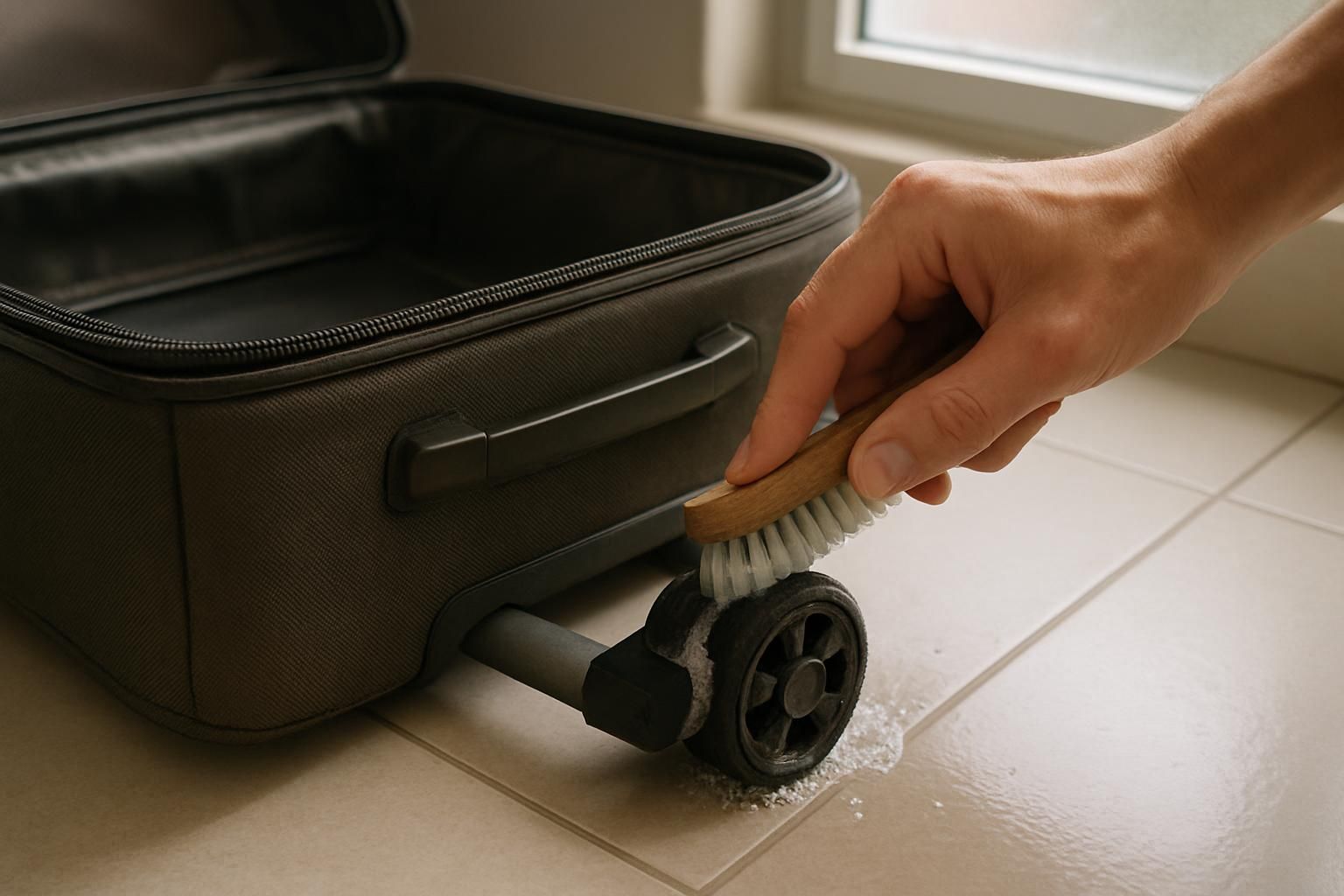
Don’t skip the tiny trouble spots handles, zippers, wheels, and bases collect grime faster than a toddler finds mud; check out the next steps to keep every inch spick-and-span.
Handles and zippers
Spray handles and zippers with an alcohol-based solution. Wipe everything down with a microfiber cloth to kick germs to the curb. Keep surfaces wet for at least 30 seconds for proper sanitization.
Skip bleach or harsh chemicals to protect metal finishes and plastic parts from damage.
Plastic handles like a little pampering, too. Use automotive trim restorer to bring back shine and color without fuss. Leather handles call for Bickmore Saddle Soap, which cleans and conditions in one go; âA clean leather handle feels like new luggage, as Grandma used to say.
Scrub away grime on handles using an all-purpose cleaner if kids’ sticky hands strike again. Good cleaning tricks help keep hygiene top-notch while extending your suitcase’s lifespan no magic spells required, just basic care and maintenance!
Wheels and base
Handles and zippers catch most fingerprints, but suitcases roll through mud, gunk, and mystery puddles. Wheels are often the dirtiest parts. Parents spot everything that sticks to those treads! Start by picking out stones or hair from the grooves so nothing scratches the wheels later.
Dip a microfiber towel in soap and water or use an all-purpose cleaner for stubborn grime. Wipe each wheel and focus on the base where dirt hides near corners. For serious cleaning, grab a screwdriver to remove the wheels, scrub them well, then pop them back on no lost socks here! Dry every piece with a clean cloth so no streaks show up on your floors.
Bleach or abrasive cleaners break down plastic fast; skip those so luggage lasts longer than last year’s math homework.
Tips for Eco-Friendly Luggage Cleaning
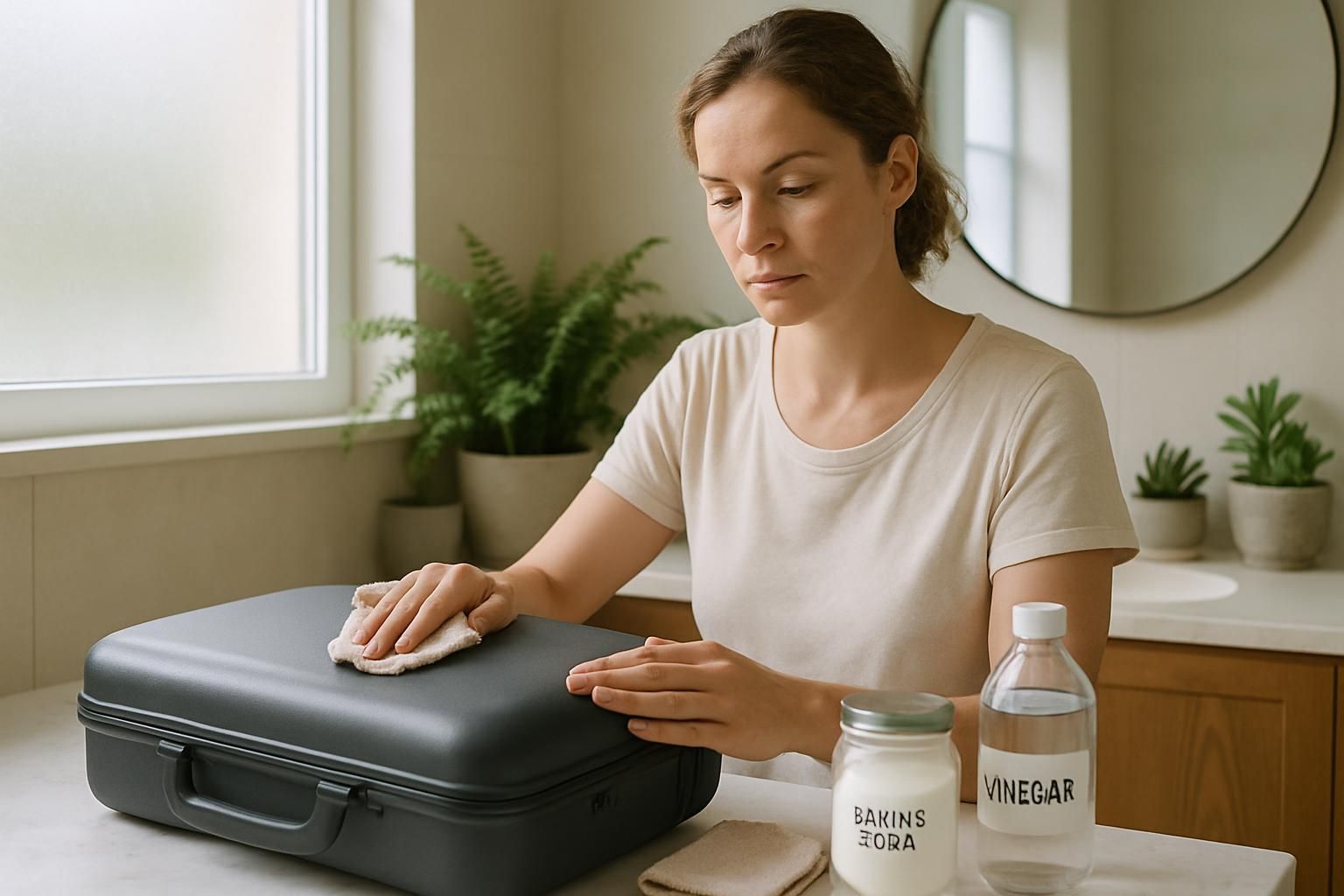
Switch to gentle cleaners like vinegar or baking soda, and check out more simple tricks for greener suitcase care right below.
Using natural cleaning solutions
White vinegar gets rid of germs and scuff marks on suitcases. Mix one part white vinegar with two parts water for an ecofriendly cleaner that beats most chemical sprays. Wipe down hard or soft luggage with this blend using a microfiber cloth to save trees and avoid waste.
Baking soda wins the prize for best household remedy when odors or stains dig in their heels, even after a trip to the beach with three kids and two dogs.
Mild soap or gentle detergent keeps both hard-sided and fabric cases looking sharp without damaging finishes. Parents who swap harsh cleaning agents for nontoxic options create safer spaces for their families no mysterious fumes, no worries about little hands touching surfaces later.
Cleaning green helps protect the planet while tackling dirt, so everyone wins even your suitcase.
Avoiding harsh chemicals
Skip the bleach and those strong solvents. Bleach can rob luggage of its color and strength, leaving ugly marks behind. Abrasive cleaners may scratch or tear both hard shells and fabric cases.
Parents can keep things safer by using nontoxic cleaning products like gentle upholstery sprays for tough stains. Try a mix of mild soap with water as a surface cleaner; this works well on most materials.
Check every new product by testing it on a hidden spot first. No one wants faded patches after hours of scrubbing! Protective sprays such as Scotchgard need careful use; spraying too much could harm fabric care instead of helping it last longer.
Light dabs with natural stain removers protect kids and pets from strong fumes while keeping your bag in shape for your next trip.
Properly Storing Your Luggage After Cleaning
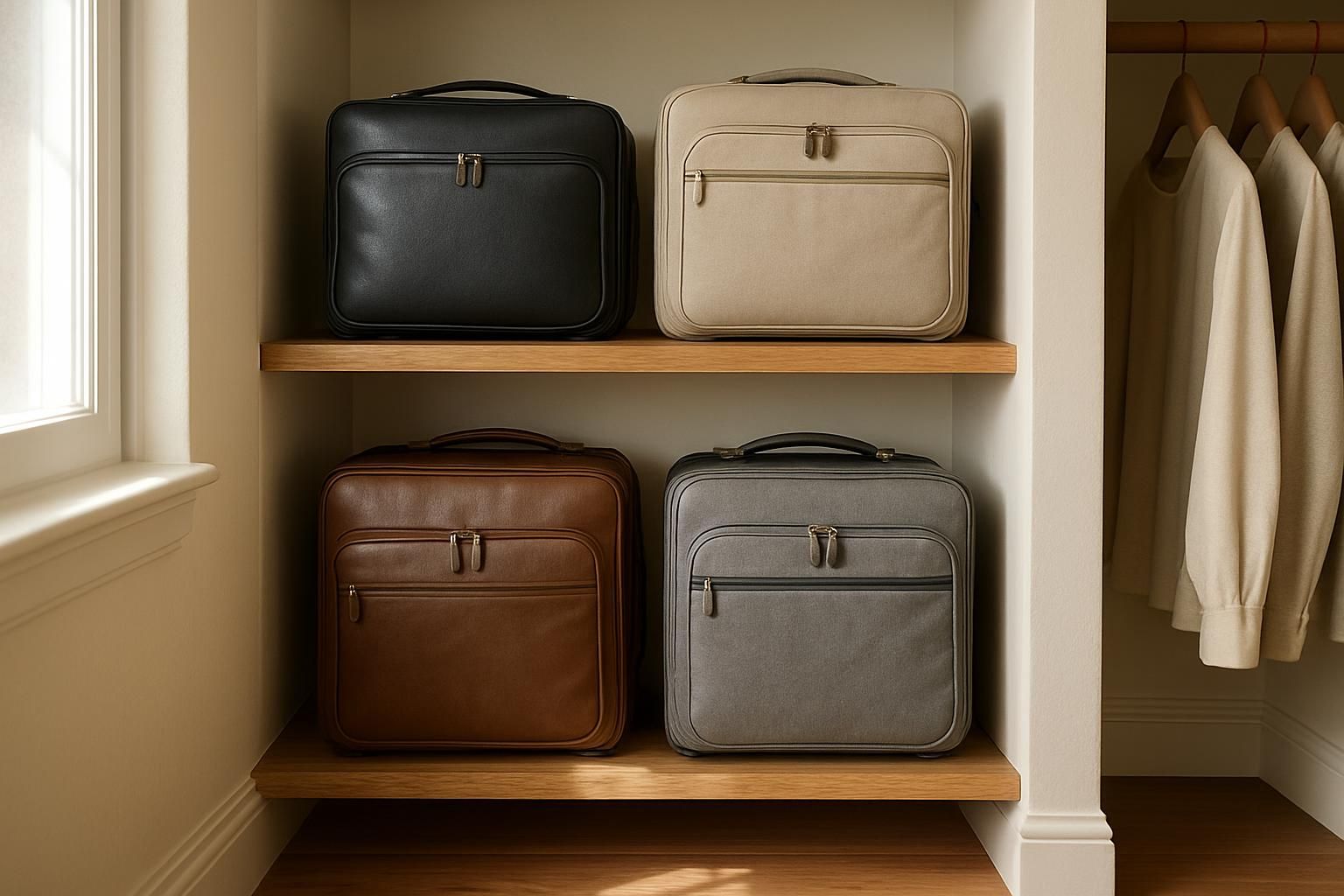
After cleaning, stash your suitcase in a cool, dry spot to keep musty smells at bay and give dust the boot stick around for smart tips that’ll save you future headaches.
Preventing mold and dust buildup
Sunlight works wonders for moisture control. Dry luggage in direct sun for several hours to block mold and mildew growth. Skip the hairdryer or heater; they can warp handles, melt linings, or crack cases faster than a bored toddler with a marker.
Store your suitcase in a dry, cool spot that’s not your bedroom. Make sure every part is bone-dry before it goes away. Toss out vacuum bags and any cleaning debris outside the house to keep dust and bugs far from your closet.
Good air flow also helps cut down on musty smells and stops nasty surprises when you open the case next time.
Using protective covers
A protective cover can work wonders for luggage protection. It acts as a dust cover and keeps dirt and grime from settling onto your clean suitcase. Some brands even toss in cloth bags or specialty covers right in the box, made just for storage solutions at home.
Think of these travel accessories like pajamas for your cases; they keep scuffs at bay and help with suitcase maintenance.
If space is tight and storage must happen in a bedroom, parents should bag up the luggage tightly and seal it. This step blocks out sneaky pests that love dark corners almost as much as socks vanish from dryers.
Using protective covers helps extend the life of each suitcase by minimizing both dust build-up and scratches over time. Investing in simple protective bags beats discovering sticky hand prints or dusty wheels before vacation begins!
Posttrip Luggage Cleaning Checklist
- Remove all items from the suitcase immediately after travel.
- Vacuum inside and out to clear loose dirt for improved baggage hygiene.
- Wipe high-touch areas with disinfecting cleaning solutions to enhance travel gear sanitization.
- Allow the luggage to dry completely before storing, ensuring proper interior sanitation.
- Store the suitcase in a cool, dry place to support long-term suitcase maintenance.
How Often Should You Clean Your Luggage?
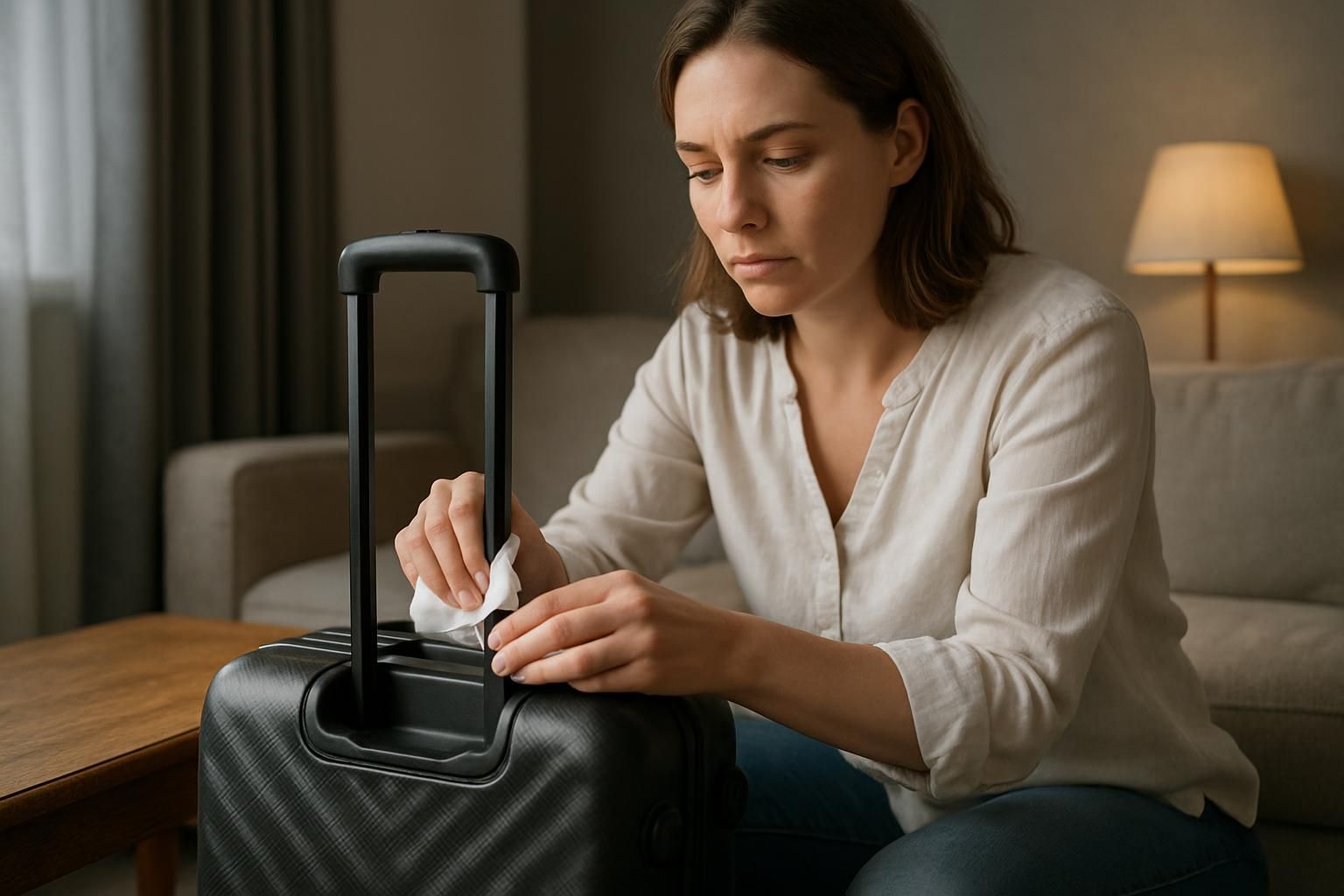
Kids and pets track in dirt, so suitcases pick up grime fast. Parents should clean luggage after every trip to keep germs at bay and avoid bringing home bugs. Wipe down handles, wheels, and zippers each time you return from traveling for better hygiene.
Even if the suitcase stays tucked away most of the year, give it a quick cleaning every few months for proper maintenance.
A simple carry-on takes about 15 minutes to clean. Regular surface cleaning helps extend durability and keeps luggage looking its best longer. Sanitizing inside prevents odors while debris removal stops dust from piling up.
Travel may be messy, but a tidy suitcase promises safe packing next round!
When to Consider Professional Luggage Cleaning Services
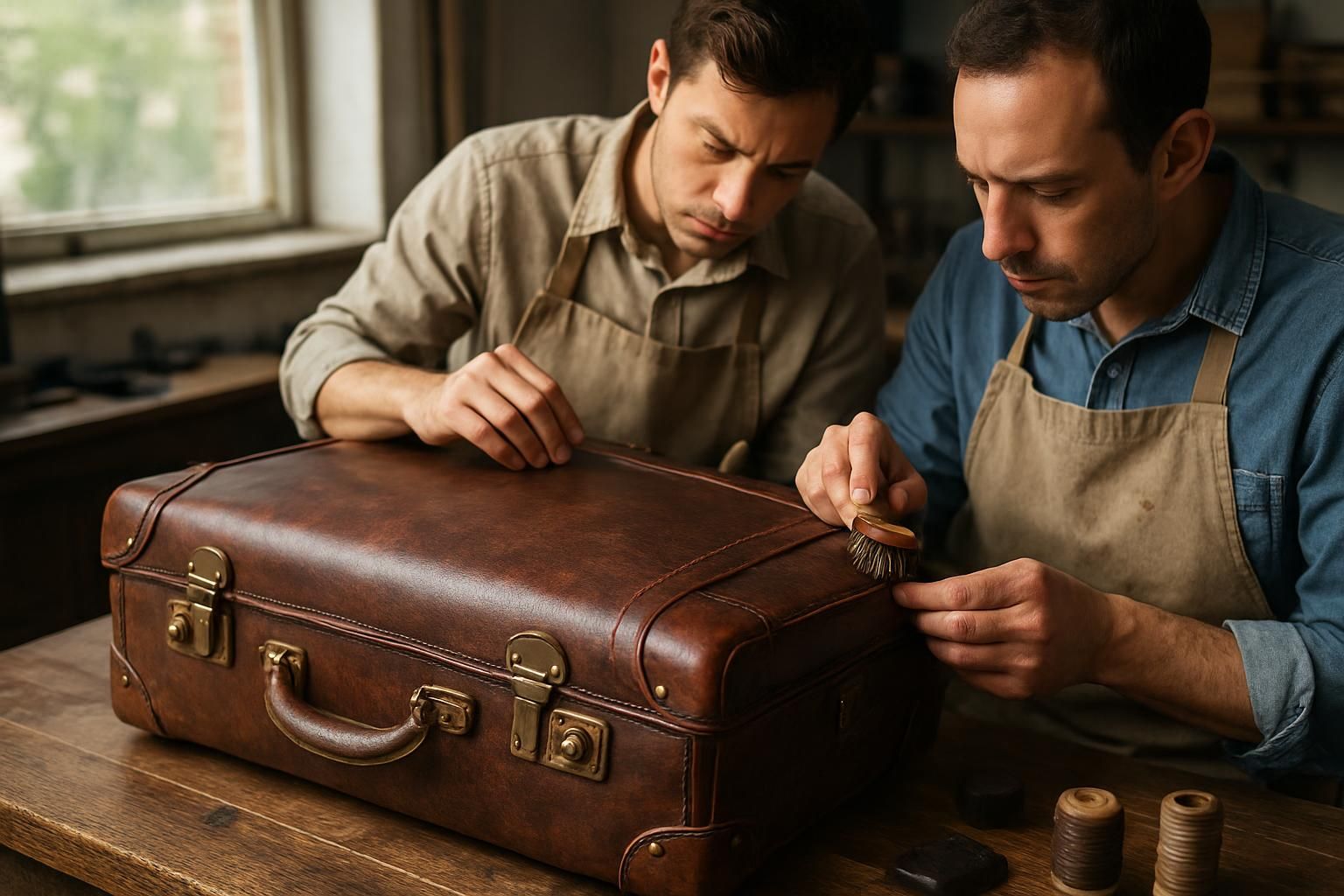
After learning how often to clean luggage at home, sometimes it just does not cut the mustard. Persistent stains that laugh in the face of every cleaning product need professional touch.
Deep odors and pesky mold also dig in their heels and ignore home treatments. Expert cleaners use equipment that tackles these problems right at their roots.
High-end bags or any suitcase still under warranty should go straight to specialists if there is a big mess. Home fixes can void coverage before you know it. If scuffed leather refuses to shine after Bickmore Saddle Soap, leave it for those with steady hands and sharp eyes.
Suspected bed bugs? Skip worry let professionals clear all doubts and contamination quickly. Broken wheels or handles do best with structural repair from certified luggage maintenance teams instead of a well-meaning dad’s toolbox on Sunday afternoon.
Conclusion
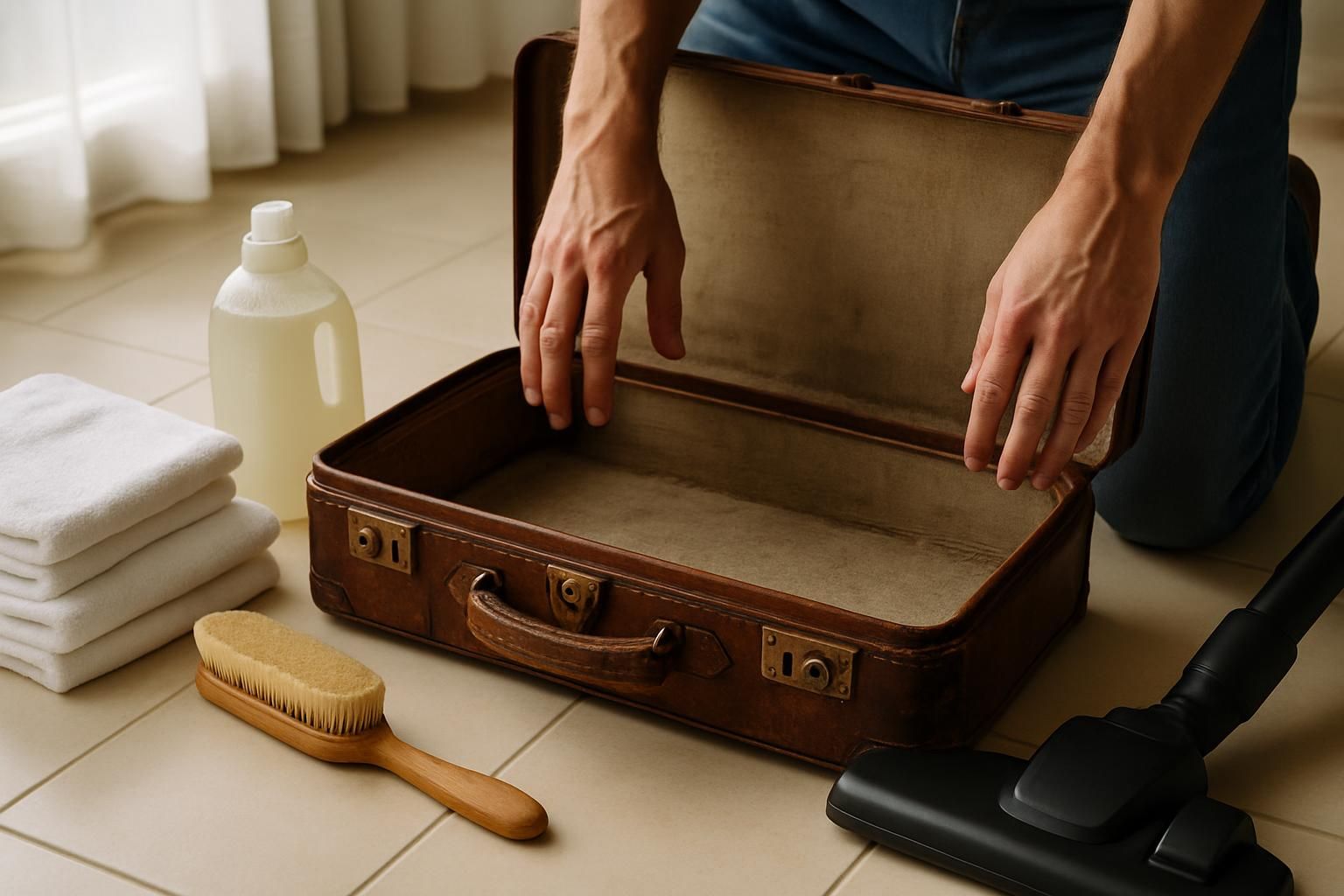
Every suitcase carries stories and a bit of grime. Clean luggage stands ready for the next adventure. Parents and homebodies can keep travel gear clean with regular care. Stains, odors, and dust don’t stand a chance if you use these expert tips.
Give your bags the attention they need; they will shine for every journey.
FAQs
1. What’s the best way to clean my luggage?
To get your suitcase sparkling, start by emptying it out completely. Use a vacuum cleaner to remove dust and debris from inside. Then, make a gentle cleaning solution with warm water and mild soap or detergent. Using a soft cloth or sponge, wipe down all surfaces of your luggage both inside and outside.
2. Can I use any type of soap for cleaning my suitcase?
While you might be tempted to grab the strongest cleaner in your cupboard, it’s better to stick with mild soaps or detergents when washing your luggage. Harsh chemicals can damage certain materials like leather or fabric.
3. How often should I clean my suitcase?
Well, there’s no hard rule here! But as an expert tip – giving your bag a quick wipe-down after each trip keeps it looking fresh and ready for the next adventure!
4. Is there any special care required for leather suitcases?
Absolutely! Leather suitcases require some extra love and care compared to their fabric counterparts; they need conditioning along with regular cleaning to prevent drying out and cracking.






